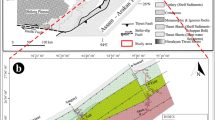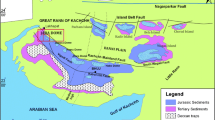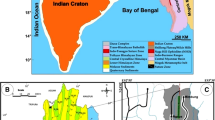Abstract
Petrography and whole-rock geochemical analysis of the Miocene Bhuban Formation exposed in the Jampui Anticline of Tripura Fold Belt, Tripura, India was carried out to reveal the provenance, depositional environments, tectonic setting and intensity of paleo-weathering of the source rocks at that period is described in this work. The Bhuban sandstones have an average detrital framework composition of Q(92.51%), F(4.44%) and RF(3.05%). The sandstones are mostly composed of quartz arenite and subarkose with subordinate sublithic arenite and their bulk-rock geochemistry support the petrographic results. The provenance discrimination diagrams depict the derivation of the detritus from both plutonic and metamorphic source rocks having affinity of continental block provenance with a minor trace of the recycled source. The sandstones have moderate SiO2 contents (61.38–70.85%; average 64.04%), constitute the major portion of the oxides followed by Al2O3 (12.42–18.35 wt%) and Fe2O3 (3.73–7.44 wt%). Compared to the average sandstone value, the Bhuban sandstones are depleted in the CaO (1.73% avg.), Na2O (1.19%), K2O (2.80%) and enriched in SiO2, Al2O3 and Fe2O3. The geochemical characteristics suggest an active continental margin and oceanic island arc setup for the Bhuban sediments. The Chemical Index of Alteration (CIA) values (43.52–74.71) indicate low to moderate nature of chemical weathering of the source areas. Whereas the Chemical Index of Weathering (CIW) values (47.22–88.72) indicate low to higher degree of weathering in the source region. The Eu/Eu* 0.65, (La/Lu)N (10.48), La/Sc (2.97), Th/Sc (1.81), La/Co (0.92), Th/Co (0.55), Th/Cr (0.16) and Cr/Th (6.66) ratios as well as chondrite-normalized rare earth elements (REE) patterns with flat heavy rare earth elements (HREE) (Gd/YbN = 1.69–2.17), enrichment of Light Rare Earth Elements (LREE) (La/SmN = 3.10–3.73) and negative Eu anomaly support a felsic source rocks for the sandstones and shale of the Bhuban Formation.















source rocks. b Th vs. Th/U plot after McLennan and Hanson (1993) representing the weathering trend of Bhuban sediments
Similar content being viewed by others
References
Alam, M., Alam, M.M., Curray, J.R., Chowdhury, M.L.R, & Gani, M.R. (2003). An overview of the sedimentary geology of the Bengal Basin in relation to the regional tectonic framework and basin-fill history. In: M.M. Alam and J.R. Curray (Eds.), Sedimentary geology of the Bengal Basin, Bangladesh, in relation to the Asia-Greater India collision and the evolution of the eastern Bay of Bengal. Sedimentary Geology, 155, 179–208.
Basu, A., Young, S. W., Suttner, L. J., James, W. C., & Mack, G. H. (1975). Re-evaluation of the use of undulatory extinction and polycrystallinity in detrital quartz for provenance interpretation. Journal of Sedimentary Research. https://doi.org/10.1306/212F6E6F-2B24-11D7-8648000102C1865D
Bhatia, M. R. (1983). Plate tectonics and geochemical composition of sandstones. The Journal of Geology, 91, 611–627. https://doi.org/10.1086/628922
Bhatia, M. R., & Crook, K. W. (1986). Trace element characteristics of greywacke and tectonic setting discrimination of sedimentary basins. Contributions to Mineralogy and Petrology, 92, 181–193. https://doi.org/10.1007/BF00375292
Blatt, H., & Christie, J. M. (1963). Undulatory extinction in quartz of igneous and metamorphic rocks and its significance in provenance studies of sedimentary rocks. Journal of Sedimentary Research, 33, 559–579.
Blatt, H., Middleton, G., & Murray, R. (1980). Origin of sedimentary rocks. Prentice-Hall.
Bracciali, L., Marroni, M., Luca, P., & Sergio, R. (2007). Geochemistry and petrography of Western Tethys Cretaceous sedimentary covers (Corsica and NorthernApennines): From source areas to configuration of margins. Geological Society of America Special Paper, 420, 73–93. https://doi.org/10.1130/2006.2420(06)
Cox, R., Lowe, D.R., & Cullers, R.L. (1995). The influence of sediment recycling and basement composition on evolution of mudrock chemistry in the southwestern United States. Geochim. Cosmochim. Acta, 59, 2919–2940. https://doi.org/10.1016/0016-7037(95)00185-9.
Crook, K.A.W. (1974). Lithogenesis and geotectonics: The significance of compositional variation in flysch arenites (greywackes). In: Dott, R. H., Jr. and Shaver, R. H., (eds.), Modern and ancient geosynclinals sedimentation, Society for Ecology Paleology Mineralogy Special Publications, 19, 304–310.
Cullers, R. L. (1994). The controls on the major and trace element variation of shales, siltstones, and sandstones of Pennsylvanian–Permian age from uplifted continental blocks in Colorado to platform sediment in Kansas, USA. Geochimica Et Cosmochimica Acta, 58, 4955–4972. https://doi.org/10.1016/0016-7037(94)90224-0
Cullers, R. L. (2000). The geochemistry of shales, siltstones and sandstones of Pennsylvanian–Permian age, Colorado, USA: Implications for provenance and metamorphic studies. Lithos, 51, 181–203. https://doi.org/10.1016/S0024-4937(99)00063-8
Cullers, R. L., & Podkovyrov, V. N. (2002). The source and origin of terrigenous sedimentary rocks in the mesoproterozoic Ui group, southeastern Russia. Precambrian Research, 117, 157–183. https://doi.org/10.1016/S0301-9268(02)00079-7
Dabbagh, M. E., & Rogers, J. J. (1983). Depositional environments and tectonic significance of the Wajid sandstone of southern Saudi Arabia. J African Earth Sci, 1, 47–57.
Dickinson, W. R. (1970). Interpreting detrital modes of graywacke and arkose. Journal of Sedimentary Petrology, 40, 695–707.
Dickinson, W. R. (1985). Interpreting provenance relations from detrital modes of sandstones. In G. C. Zuffa (Ed.), Reading provenance from arenites (pp. 333–362). Dodrecht: Reidel. https://doi.org/10.1007/978-94-017-2809-6_15
Dickinson, W. R., Beard, L. S., Brekenridge, G. R., Erjavec, J. L., Ferguson, F. A., Inman, K. F., Knepp, R. P., Lindberg, F. A., & Ryberg, P. T. (1983). Provenance of North American Phanerozoic sandstones in relation to tectonic setting. Geological Society of America Bulletin, 94, 222–235.
Dickinson, W. R., & Suczek, C. A. (1979). Plate tectonics and sandstone compositions. American Association of Petroleum Geologists Bulletin, 63, 2164–2182. https://doi.org/10.1306/2F9188FB-16CE-11D7-8645000102C1865D
Evans, P. (1932). Tertiary succession in Assam. Transactions of Mining and Geological Institute of India, 27(3), 155–260.
Evans, P. (1964). Tectonic framework of Assam. Journal of Geophysical Society of India, 5, 80–96.
Fedo, C. M., Nesbitt, H. W., & Young, G. M. (1995). Unravelling the effects of potassium metasomatism in sedimentary rocks and paleosols, with implications for paleoweathering conditions and provenance. Geology. https://doi.org/10.1130/0091-7613(1995)023%3c0921:UTEOPM%3e2.3.CO
Folk, R. L. (1974). Petrology of sedimentary rocks (2nd ed., p. 182). Hemphill Press.
Folk, R. L. (1980). Petrology of sedimentary rocks. Hemphill’s.
Fyffe, L. R., & Pickerill, R. K. (1993). Geochemistry of Upper Cambrian–Lower Ordovician black shale along a northeastern Appalachian transect. Geological Society of America Bulletin, 105, 897–910. https://doi.org/10.1130/0016-7606(1993)105%3c0897:GOUCLO%3e2.3.CO;2
Ganguly, S. (1983). Geology and hydrocarbon prospects of Tripura–Cachar–Mizoram region. Petroleum Asia Journal, 1, 105–109.
Gani, M. R., & Alam, M. M. (1999). Trench-slope controlled deepsea clastics in the lower Surma Group in the Southeastern fold belt of the Bengal Basin, Bangladesh. Sedimentary Geology, 127, 221–236.
Gani, M. R., & Alam, M. M. (2003). Sedimentation and basin-fill history of the Neogene clastic succession exposed in the southeastern fold belt of the Bengal Basin, Bangladesh: a high-resolution sequence stratigraphic approach. Sedimentary Geology, 155, 227–270.
Grantham, J.H., & Velbel, M.A. (1988). The influence of climate and topography on rockfragment abundance in modern fluival sands of the southern Blue Ridge Mountains, North Carolina. J. Sediment. Petrol. 58, 219–227. https://doi.org/10.1306/212F8D5F-2B24-11D7-8648000102C1865D.
Haque, M. M., Roy, M. K., Joly, N. S., Roy, P. J., & Malik, A. R. (2010). Sequences stratigraphy of the Surma Group of rocks, Bandarban Anticline, Chittagong Hill Tracts, Bangladesh. International Journal of Earth Sciences and Engineering (IJEE), 03(03), 341–356.
Harnois, L. (1988). The CIW index: A new chemical index of weathering. Sedimentary Geology, 55, 319–322. https://doi.org/10.1016/0037-0738(88)90137-6
Hayashi, K. I., Fujisawa, H., Holland, H. D., & Ohmoto, H. (1997). Geochemistry of ∼1.9 Ga sedimentary rocks from northeastern Labrador, Canada. Geochimica Et Cosmochimica Acta, 61, 4115–4137. https://doi.org/10.1016/S0016-7037(97)00214-7
Hossain, M.S., Khan, M.S.H., Chowdhury, K.R., & Abdullah, R. (2019). Synthesis of the tectonic and structural elements of the Bengal Basin. In: Mukherjee, S. (Ed.), Tectonics & Structural Geology: Indian Context. Springer International Publishing AG, Cham, p. 84. https://doi.org/10.1007/978-3-319-99341-6.
Ingersoll, R. V., Bullard, T. F., Ford, R. L., Grimm, J. P., Pickle, J. D., & Sares, S. W. (1984). The effect of grain size on detrital modes: A test of the Gazzi–Dickinson point-counting method. Journal of Sedimentary Petrology, 54, 103–116.
Ingersoll, R. V., & Suczek, C. A. (1979). Petrology and provenance of Neogene sand from Nicobar and Bengal fans, DSDP sites 211 and 218. Journal of Sedimentary Petrology, 49, 1217–1228.
Jafarzadeh, M., & Hosseini-Barzi, M. (2008). Petrography and geochemistry of Ahwaz Sandstone Member of Asmari Formation, Zagros, Iran: Implications on provenance and tectonic setting. Revista Mexicana De Ciencias Geológicas, 25(2), 247–260.
Jayaram, S., Venkatasubramaniam, V.S. & Radhakrishna, B.P. (1983). Geochronology and trace element distribution in some tonalitic and granitic gneisses of the Dharwar craton. In: Naqvi, S.M. and Rogers, J.J.W. (eds.), Proceedings of the Indo-US workshop, Hyderabad. Precambrian of south India, Memoir of Geological Society of India, 8, 377–389.
Jinliang, Z., & Xin, Z. (2008). Composition and provenance of sandstones and siltstones in Paleogene, Huimin Depression, Bohai Bay Basin, Eastern China. Journal of China University of Geosciences, 19, 252–270. https://doi.org/10.1016/S1002-0705(08)60044-8
Johnson, S. Y., & Alam, A. M. N. (1991). Sedimentation and tectonics of the Sylhet trough, Bangladesh. Geological Society of American Bulletin, 103, 1513–1527.
Jokhan, R. (1984). Tectonic framework &andHydrocarbon prospects of Mizoram. Petroleum Asian Journal, 7(1), 60–85.
Khanehbad, M., Moussavi-Harami, R., Mahboubi, A., & Nadjafi, M. (2012). Geochemistry of carboniferous shales of the Sardar Formation, East Central Iran: Implication for provenance, Paleoclimate and Paleooxygenation conditions at a passive continental margin. Geokhim, 50(9), 867–880.
Khar, B.M., & Ganju. J.C. (1984). Tectonics of Tripura fold belt—probable mechanics of folding and faulting. Petroleum Asian Journal, 7, 142–151
Kroonenberg, S. B. (1992). Effects of provenance, sorting and weathering on the geochemistry of fluvial sands from different tectonic and climatic environments. In: Proceedings 29th International Geological Congress, pp. 69–81.
McLennan, S. M. (1989). Rare earth elements in sedimentary rocks: influence of provenance and sedimentary processes. In: Lipin, B.R., Mckay, G.A. (Eds.), Geochemistry and mineralogy of rare earth elements. Reviews in Mineralogy, vol. 21, 169–200.
McLennan, S. M., Hemming, S., McDaniel, D. K., & Hanson, G. N. (1993). Geochemical approaches to sedimentation, provenance, and tectonics. Geological Society of America Special Paper, 284, 21–40.
McLennan, S. M., Taylor, S. R., & Eriksson, K. A. (1983). Geochemistry of Archaean shales from the Pilbara Supergroup, Western Australia. Geochimica Et Cosmochimica Acta, 47(7), 1211–1222.
McLennan, S. M., Hemming, S., McDaniel, D. K., & Hanson, G.N. (1993). Geochemical approaches to sedimentation, provenance, and tectonics. Geol. Soc. Am. Spec. Pap. 284, 21–40.
Mongelli, G., Critelli, S., Perri, F., Sonnino, M., & Perrone, V. (2006). Sedimentary recycling, provenance and paleoweathering from chemistry and mineralogy of Mesozoic continental redbed mudrocks, Peloritani mountains, southern Italy. Geochemical Journal, 40, 197–209. https://doi.org/10.2343/geochemj.40.197
Najman, Y., Mark, C., Barfod, D. N., Carter, A., Parrish, R., Chew, D., & Gemignani, L. (2019). Spatial and temporal trends in exhumation of the Eastern Himalaya and syntaxis as determined from a multitechnique detrital thermo chronological study of the Bengal Fan. Geological Society of America Bulletin, 131, 1607–1622. https://doi.org/10.1130/B35031.1
Nandy, D. R., Dasgupta, S., Sarkar, K., & Ganguly, A. (1983). Tectonic evolution of Tripura–Mizoram Fold Belt, Surma Basin, Northeast India. Quarterly Journal of the Geological, Mining, and Metallurgical Society of India, 55, 186–194.
Nesbitt, H. W., & Young, G. M. (1982). Early proterozoic climates and plate motions inferred from major element chemistry of lutites. Nature, 299, 715–717. https://doi.org/10.1038/299715a0
Osman, M. (1996). Recent to quaternary river nile sediments: A sedimentological characterization on samples from Aswan to Naga-Hammadi, Egypt. Unpublished Ph.D. thesis, University of Vienna, Vienna.
Pearson, K. (1895). Notes on regression and inheritance in the case of two parents. Proceedings of the Royal Society of London, 58, 240–242. https://doi.org/10.1098/rspl.1895.0041
Pettijohn, F. J., Potter, P. E., & Siever, R. (1972). Sand and sandstone. Springer.
Rollinson, H. R. (1993). Using geochemical data: Evaluation, presentation and interpretation. Longman.
Roser, B. P., & Korsch, R. J. (1986). Determination of tectonic setting of sandstone mudstone suites using SiO2-content and K2O/Na2O ratio. The Journal of Geology, 94, 635–650. https://doi.org/10.2307/30078330
Roy, M. K. R., Akter, M. S., Roy, P. J., Akther, S., Haque, M. N., Malik, A. R. M., & Mahmud, S. (2007). Facies analysis of Boka Bil Formation as exposed along the Barogang-Hari River section, Northeastern Sylhet, Bangladesh. The Icfai Journal of Earth Sciences, 1(1), 22–46.
Schoenborn, W. A., & Fedo, C. M. (2011). Provenance and paleoweathering reconstruction of the Neoproterozoic Johnnie Formation, southeastern California. Chemical Geology, 285, 231–255. https://doi.org/10.1016/j.chemgeo.2011.04.014
Shamsuddin, A. H., & Abdullah, S. K. M. (1997). Geologic evolution of the Bengal Basin and its implication in hydrocarbon exploration in Bangladesh. Indian Journal of Geology, 69(2), 93–121.
Sifeta, K., Roser, B. P., & Kimura, J. I. (2005). Geochemistry, provenance, and tectonic setting of Neoproterozoic metavolcanic and metasedimentary units, Werri area, Northern Ethiopia. Journal of African Earth Sciences, 41, 212–234.
Sun, L., Gui, H., & Chen, S. (2012). Geochemistry of sandstones from the Neoproterozoic Shijia Formation, northern Anhui Province, China: Implications for provenance, weathering and tectonic setting, Chemie Erde. Geochemistry, 72(3), 253–260.
Suttner, L. J., & Basu, A. (1981). Climate and the origin of quartz arenites. Journal of Sedimentary Petrology, 51, 1235–1246.
Taylor, S. R., & McLennan, S. M. (1985). The continental crust; its composition and evolution. Blackwell.
Turekian, K. K., & Michael, H. C. (1960). The geochemistries of chromium, cobalt and nickel. International Geological Congress, 1, 14–27.
Turekian, K. K., & Wedepohl, K. H. (1961). Distribution of the elements in some major units of the earth’s crust. Geological Society of America Bulletin, 72, 175–192.
Weltje, G. J. (1994). Provenance and dispersal of sand-sized sediments: Reconstruction of dispersal patterns and sources of sand-sized sediments by means of inverse modelling techniques. Geologica Ultraiectina, No.121,
Zaid, S. M. (2012). Provenance, diagenesis, tectonic setting and geochemistry of Rudies sandstone (Lower Miocene), Warda Field, Gulf of Suez, Egypt. Journal of African Earth Sciences, 66–67, 56–71.
Acknowledgements
The authors are grateful to the authorities of the Applied Geology Department, Dibrugarh University for providing laboratory facilities. We would like to thank Director, Wadia Institute of Himalayan Geology (WIHG), Dehradun for providing facilities in geochemical analysis. We are also thankful to the Editor-in-chief, Prof. Maria Virginia Alves Martins and the two anonymous reviewers for their very constructive comments and suggestions to improve the manuscript.
Author information
Authors and Affiliations
Corresponding author
Additional information
Communicated by M. V. Alves Martins
Publisher's Note
Springer Nature remains neutral with regard to jurisdictional claims in published maps and institutional affiliations.
Rights and permissions
About this article
Cite this article
Borgohain, K., Sarmah, R.K. Petrography and whole-rock geochemistry of the Miocene Bhuban Formation of Tripura Fold Belt, North District, Tripura, India: implications for provenance, tectonic setting and weathering intensity. J. Sediment. Environ. 7, 211–235 (2022). https://doi.org/10.1007/s43217-022-00092-9
Received:
Revised:
Accepted:
Published:
Issue Date:
DOI: https://doi.org/10.1007/s43217-022-00092-9






